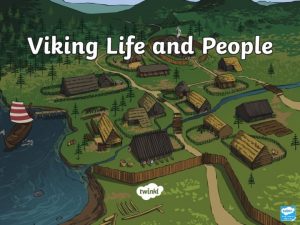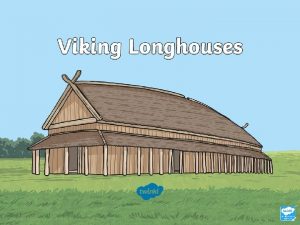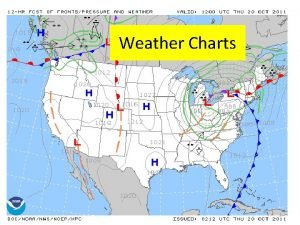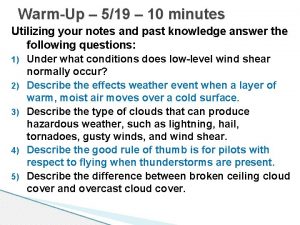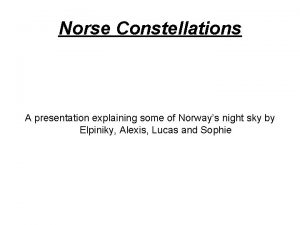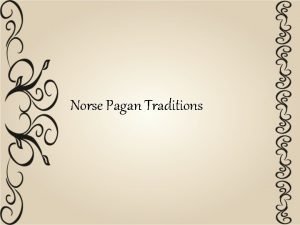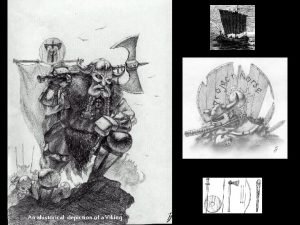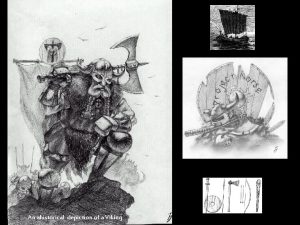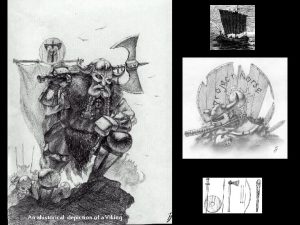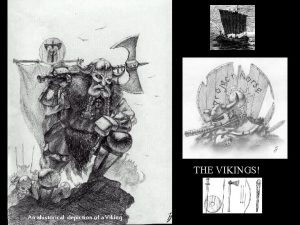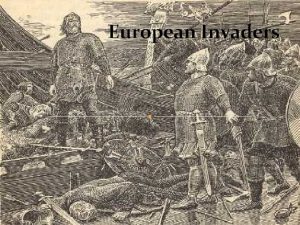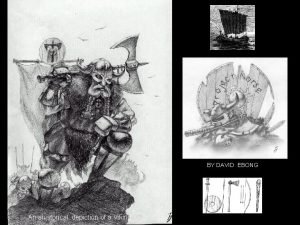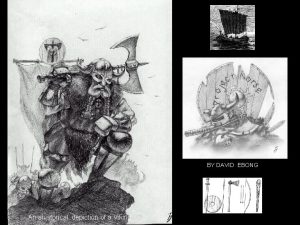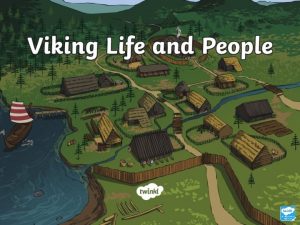An ahistorical depiction of a Viking Who Were










- Slides: 10

An ahistorical depiction of a Viking

Who Were the Vikings? • • • The Vikings, or Norse, were a race of Scandinavian warriors who raided Northern Europe, Eastern Asia, and Eastern North America. By the end of the first millennium the Vikings reached North America five hundred years before Columbus. The word “Viking” also describes a whole new age in Europe between about the mid 700 to 1150 AD. This was a period of raiding as well as creating far trade networks of settlements by Scandinavians.

What were their goals? • Raids and loot were not the whole story of the Vikings. Land to farm was also a commodity. There were limited sources of food. • Unlike many other invaders in history, the vikings weren’t trying to spread their religion that was paganism, rather gain new resources and new connections. They wanted political and economical advantage. • They had to find food, live off the land, and set up shop. They drove people out and took their money and other valuables they had. Vikings targeted the church and monasteries, which were the major sources of wealth at the time. An accurate depiction of what a Viking looked like.

Ships and Navigation We know what their ships looked like because many vikings were buried with their goods that sometimes included their boats. • • They had swift wooden long ships, equipped with sails and oars. Figureheads would be raised at stem and stern as a sign of war.


Battles and Tactics • Vikings had no professional standing army and tactics and discipline seemed at little development. They didn’t fight in regular formations • Weapons training began at youth in hunting, sports, and raiding. • The famous Berserker warriors fought in groups, and believed that Odin, their god of war, gave them both protection and superhuman powers so they had no need for armor. Berserker battles were intense and it’s said they bit on their shields and could ignore the pain of wounds. Many experienced vikings formed a wedge of 20 to 30 men and would then charge at the enemy. They fought mainly on foot. The largest armies may have been 4, 000 to 7, 000 men. After war Vikings would return to lives as farmers, merchants, craftsmen, or join other war-bands.

Offensive Weapons • The main offensive weapons were the spear, sword, and battle-axe.

Defensive Weapons • There were circular shields up to one meter across that were carried. The shield may have been leather covered. Around 1000, the kite shaped shield was introduced to the Vikings to provide more protection for the legs. An accurate viking helmet left. The mail armor shown right. • They used long tunics of mail armor reaching below the waist. A modern myth!!!

Conquests • The first Viking raids were hitand -run affairs. There was no coordination and long term plan behind them. • Vikings raided the British Isles and the Western portions of the Carolingian Empire in France. They conquered much of Northern England in the 9 th century, and they established a kingdom in Ireland. • In return for cash Vikings negotiated peace with their enemies. • 982 Erik the Red founded Greenland. • Leif Erikson later landed on North America.

What happened to the Vikings? • Vikings became citizens of many places in Europe. • Many had become Christians back in their homelands. This lead to the downfall of the Norse religion and culture. • Kings instituted taxes and the economy changed so that you could get along better off as a trader than a raider. • The Viking invasions caused European kingdoms to adopt the system of Feudalism and create massive fortresses like Castles
 What were viking houses like
What were viking houses like Why were viking longhouses smelly?
Why were viking longhouses smelly? Weather depiction chart legend
Weather depiction chart legend Terminal aerodrome forecast
Terminal aerodrome forecast Weather depiction chart
Weather depiction chart Of what value is the weather depiction chart to the pilot
Of what value is the weather depiction chart to the pilot Oldest icon of jesus
Oldest icon of jesus What wind is forecast for stl at 12 000 feet
What wind is forecast for stl at 12 000 feet Difax
Difax Thiazi's eyes constellation
Thiazi's eyes constellation Norse reconstructionism
Norse reconstructionism
